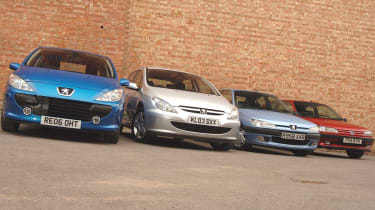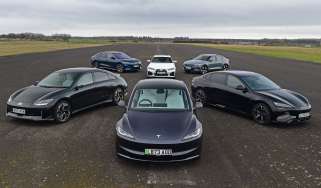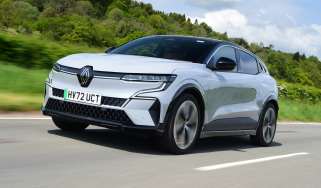Peugeot 306/307
The French hatchback has been a favourite in the UK for more than a decade - but which version is best?
By combining great looks with fine handling, Peugeot proved that there was much more to family hatches than practicality and mobility when it launched the 306 in 1993. Eight years later, in 2001, the more spacious 307 arrived, and competitive pricing made it excellent used value, too. Here, we look at the past four generations of the French firm’s family car line-up.
With its curvy, modern design, the 306 was a stylish alternative to the Ford Escort and Vauxhall Astra, while its supple ride and sharp handling were bettered only by those of the later Ford Focus. As a result, the 306 won the hearts of family buyers and boy racers alike.
There are plenty of engines; the diesels hold the broadest appeal, but petrols include 1.4, 1.6 and 1.8-litre units, as well as the spicy 123bhp 2.0 XSi, rare 155bhp S-16 and storming 167bhp 2.0 GTi-6. Oil-burners are a 92bhp 1.9-litre turbodiesel and 70bhp non-turbo version; the former is the pick of the bunch. A 1997 facelift brought a new grille, lights and trim range, plus metal-look console, while the excellent 90bhp 2.0 HDi diesel arrived in 1999.
The sensible 307 is more practical, with extra space, a decent chassis and better refinement. Larger in most dimensions, it also provides a revised engine line-up, which is topped by fine new turbodiesels. But the weight of all the extra kit means the driving experience isn’t as thrilling as before.
Facelifted last year, the 307 now has the gaping-mouthed Peugeot front end. Many of the electrical gremlins of the original car were also fixed. A pair of 1.6-litre HDi units, producing 90bhp or 110bhp, and a 136bhp 2.0 HDi replaced the existing oil-burners, too.
VERDICT
Our choice: Peugeot 307 (2001-2005)
The original 307 is the cream of the crop. Hefty depreciation ensures these models represent great value when bought second-hand – while the latest variants, which are available nearly new, offer the added bonus of the balance of the manufacturer’s warranty. Our pick of the bunch is the 136bhp diesel in sporty and well equipped XSi guise. Even one on sale on a dealer’s forecourt should be within reach for £7,000.
Extra Info
306
Price range: £500-£4,000 Manufactured from: 1993-1997
The first 306 models are now 13 years old and, while the build quality is reasonable, there are a few things to be wary of. Diesels need servicing every 6,000 miles, and common problems include head gasket issues, caused by low coolant levels. All 306s require a cambelt change every three years or 36,000 miles, while front suspension wear is common – so listen out for unusual creaks and rattles.
Equipment isn’t generous, and many ‘essentials’ you take for granted today might not be fitted. Basic early cars will lack ABS, which was optional, and a driver’s airbag. Also, entry-level models won’t all have power-steering, which is vital on heavy, torquey diesels. You’re unlikely to find examples at a franchised dealer, yet they’re popular at second-hand specialists and in the classifieds. Stylish cabriolets can fetch as much as £4,000, but avoid unpopular saloons.
306 facelift
Price range: £1,000-£8,500 Manufactured from: 1997-2001
The 1997 facelift resolved few mechanical issues, yet with the revised grille and lights came a standard-fit driver airbag. ABS was still an option on most variants, but this was standardised from 1999, along with twin airbags. Trim-wise, L, LX and GLX replaced the old car’s XN, XL, XR, and XT designations.
Post-1999 cars have remote central locking and split-folding rear seats, and a practical estate joined the existing hatch, saloon and convertible. As with the original 306, petrol models suffer fuel line problems, which can easily be rectified with new pipes, while excessive black smoke suggests a worn turbo on diesel models. Watch out for GTi-6 and Rallye variants which have been heavily abused; a mechanical inspection on these is recommended.
307
Price range: £3,000-£16,000 Manufactured from: 2001-2005
In 2001, the 306 was replaced by the larger, taller 307. Launched as a three and five-door, it gave the choice of 1.4, 1.6 and 2.0-litre petrol engines, while oil-burners ranged from the 70bhp 1.4 to 90bhp or 110bhp 2.0-litre HDi. The brilliant 136bhp HDi arrived in 2004. Generally, the diesels are better than the thrashy petrols, thanks to their excellent economy, refinement and pace.
However, reliability isn’t the 307’s forte, with several annoying niggles. Problems such as jamming starter motors, dodgy cabin quality and flimsy indicator stalks will all grate. Find a car from after mid-2002 and it will have better switchgear. The underrated SW estate also appeared that year, with a seven-seat option, while the CC coupé-cabriolet arrived in 2003.
307 facelift
Price range: £8,000-£22,000 Manufactured from: 2005 to date
You'll spot the current 307 from its distinctive wide-mouthed grille and new front and rear lights, yet there are a few less obvious – but important – changes, too. The electrical system has been improved, although mechanical glitches and problems with the air-con controls are still common.
The new look was also accompanied by a restructured model line-up; the E replaces the Style as the entry car. This has electric mirrors, a CD player and plenty of safety kit, but lacks air-con. Any second-hand 307 will still be protected by the manufacturer’s warranty, and there’s a huge selection of approved stock on the Lion Used Car scheme – which only includes models with a full service history. Many late-plate examples will be ex-fleet, and as long as the service book is fully stamped, they shouldn’t pose a problem.



